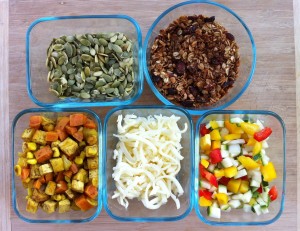 I have a confession to make. Right now I’m totally obsessed with food blogs. I love gathering recipes and ideas about cooking. Even more, I’m enthralled by how different foodies write about what they eat and cook. My current favorite is Heidi Swanson, a food writer and photographer from San Francisco. She has a website called 101 Cookbooks and I like how she uses local, seasonal produce and tries to keep her recipes to about six ingredients. She includes exquisite photographs with her writing and from time to time offers a list of favorites. Her August list led me to a site called Purple Kale Kitchenworks. Digging further into that website, I ran across a blog by a chef who described how she labored for hours each week making baby food for her children that was like “edible silk.” She went on to say that at the same time, she was eating poorly because she didn’t have time to make quality food for herself. A plan to remedy her situation evolved based on a concept applied in professional kitchens called mise en place, or “everything in its place.” Basically this involves preparing ahead of time the small edible parts, such as shredded cheese, cooked grains, beans, hard boiled eggs or chopped vegetables, to assemble later into an array of menu options. When I read this a lightbulb went on.
I have a confession to make. Right now I’m totally obsessed with food blogs. I love gathering recipes and ideas about cooking. Even more, I’m enthralled by how different foodies write about what they eat and cook. My current favorite is Heidi Swanson, a food writer and photographer from San Francisco. She has a website called 101 Cookbooks and I like how she uses local, seasonal produce and tries to keep her recipes to about six ingredients. She includes exquisite photographs with her writing and from time to time offers a list of favorites. Her August list led me to a site called Purple Kale Kitchenworks. Digging further into that website, I ran across a blog by a chef who described how she labored for hours each week making baby food for her children that was like “edible silk.” She went on to say that at the same time, she was eating poorly because she didn’t have time to make quality food for herself. A plan to remedy her situation evolved based on a concept applied in professional kitchens called mise en place, or “everything in its place.” Basically this involves preparing ahead of time the small edible parts, such as shredded cheese, cooked grains, beans, hard boiled eggs or chopped vegetables, to assemble later into an array of menu options. When I read this a lightbulb went on.
I realized I’ve been doing this with my art lately, preparing and organizing small pieces to assemble into one-of-a-kind collages. Having an assortment of colors, textures, and shapes at my fingertips allows inspirations to manifest quickly. As I thought about this further, it occurred to me that I’ve been trying to do this in the rest of my life as well. Before school started this year I realized I needed to learn to work smarter, not harder. Mise en place has helped me to put “smarter, not harder” into action. As I continue pondering the idea, all sorts of possibilities arise.
Living with everything in its place requires first and foremost, setting clear and healthy boundaries. It means saying yes to some things, and no to others. It involves thinking ahead. For example, I’ve been in the practice of walking every morning from 6 to 6:30 before I head off to school. Time is a factor and I notice less stress in the 45 minutes before I need to walk out the door if my lunch is already made, my computer is packed up, and I know where my keys and cellphone are. Once sitting at my desk at school, I apply the same process to weekly communications. When I complete a blog post, a monthly newsletter or weekly memo, I immediately set up the next one. Throughout the week as items arise, I add them to the document so they won’t be forgotten and when time for publication arrives, the document is nearly finished. I’ve also shifted my thinking with other media projects that have multiple components. If there’s a way to incorporate some of the parts for alternative uses, I do it. It’s a lot like the chopped veggies stored in our refrigerator all week, just waiting to be part of a delicious new concoction.

I learned a few things here and now I just need to apply. Thanks Mary. Great ideas.
Orangette is my favorite. It has slowed some, but all her recipes are indexed, and her book is fantastic. Foodgawker is one my favorite ways to waste time online. Beautiful photos that you click on to go right to the recipe.